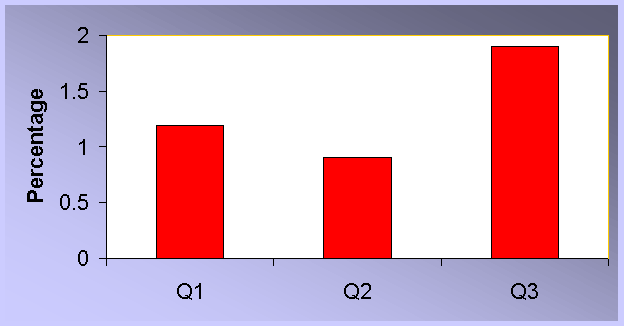
Contents
Introduction
*REAL SECTOR REVIEW
*Price developments
*Monetary and Finacial Developments
*Money Market Developments
*Capital Market Developments
*Money Supply
*Domestic Credit
*Fiscal Developments
*Balance of Payments and Exchange Rate Developments
*Current Account
*Exchange Rate Developments
*Prospects
*
The Namibian macro-economic scenario has remained quite stable during the year 2000. The economy has been able to shield itself from the external shocks like the hike in oil prices and the weaknesses of currencies witnessed on the global front. It is noteworthy that despite the adverse external shocks the Bank of Namibia (like the other monetary authorities in the Common Monetary Area) opted not to raise the level of interest rates, keeping in view the imperatives of economic growth. On the monetary front, the Bank of Namibia has been able to contain monetary expansion during 2000. The average annual growth rate of money supply during 2000 stood at 5.7 per cent as compared with a monetary expansion of the order of 18.6 per cent witnessed during 1999.The moderate monetary expansion thus helped in easing the pressure on the price level.
The money market rates in Namibia by and large remained steady or declined during the current year. However, in the wake of the higher inflation witnessed during the year the real interest rates have been declining throughout the year. The low interest rates led to a sizeable expansion in private sector credit as compared with the previous year. It has, however, been observed that while there has been a marked increase in credit to the private sector related to individuals, credit to business or investment purposes however did not take off as expected. Thus, lack of adequate flow of credit for investment purposes may have been responsible for the slow down in the growth process during the first half of 2000.
On the fiscal front, there has been an improvement as may be seen from the decline in fiscal deficit during the first half of the current fiscal year as compared with the corresponding period of the preceding fiscal year. Another encouraging development on the macro-economic scene during the first nine month of 2000 has been the strong positive current account balance, which substantially surpassed the level prevailing in the previous year. This is largely attributable to the higher level of SACU receipts this year as compared with the preceding year. It is expected that the EU-SAFTA trade arrangement may result in substantial reduction in this major item of revenue receipts. In view of this, efforts towards exploring alternative sources of revenue to avoid possible slippages in the budgetary position assumes paramount significance in years ahead.
Namibia’s economic growth in 2000 has to be seen against the background of a perceptible expansion in world economic activity in general and the longest expansion ever recorded by the United States of America during the first three quarters of 2000. While the high economic growth on the global front proved favourable in sustaining the export growth, the favourable price trends in the international commodity markets helped the country in realising the gains on the trade front besides encouraging investments in Namibia.
Expectation towards the end of 1999 was that of a remarkable upward shift in economic growth in the year 2000 and beyond. Although this is likely to be true in the ensuing year and the medium term, the near-term prospects are not that bright. The prospects for a sharper growth for the current year were, however, blighted by the passive growth evidenced during the first half of 2000. With the pessimism on the growth front spilling over to the third quarter, it is to be expected that the GDP growth for the current year may not be significantly different from the last year’s rate of growth of 3 per cent.
Chart 1. Quarterly Growth Rates: Real Gross Domestic Product, Q1 - Q3, 2000

The construction sector is still saddled with the uncertainties surrounding interest rates, mainly due to the longer time lag before the prevailing low interest rate can make an impact on the industry. As a result, the construction sector has been performing below expected levels this year. It is expected that the increase in government capital expenditure and the prevailing low interest rates would assist the revival of this sector in the second half of the year.
Despite the reopening of the former TCL mines, the mining sector activities remained subdued during the first half of the year. This is mainly, because of the poor performance by the two major minerals viz., diamonds and uranium. Diamond output recorded negative growth rates of 5.3 per cent and 9.9 per cent during the first and second quarters of 2000, respectively. Uranium output declined by 2.6 per cent and 9.4 per cent during the first and second quarters, respectively as compared with the output levels during the corresponding periods of the preceding year.
Following the good rainfall, farmers preferred to hold back their livestock this year (livestock constitute the bulk of the agriculture sector), and as a result, the agricultural sector which made a turnaround in 1999 from the declines registered in 1998 only grew marginally in the first quarter of 2000. The growth, however, did not last long and was followed by a sharp decline in the second quarter of 2000. The declining trend might continue for the rest of this year. On the other hand, cereal production was higher this year as a result of an increase in the area under cultivation and aided by good rainfall. Another welcoming development has been that ostrich production remained stable despite the devastating floods witnessed during the first quarter of this year. It may, however, be noted that the effects of the floods might only be felt next year since the birds destroyed in the floods would have been slaughtered in a years time. The new price structure for ostrich products which was announced recently by Ostrich Production Namibia compares favourably with the South African prices and will most probably motivate farmers in enhancing their investment in the industry. This would undoubtedly help to improve the performance of the industry.
The contribution of the manufacturing sector is becoming somewhat unstable. This is borne out by the fact that this sector witnessed a sizeable decline in the first quarter of 2000. This sector however showed an improvement in the second quarter. Overall, the performance of the manufacturing sector for the year will depend on the performance of the agriculture and the fishing sectors during the second half of the year.
In summary, real sector activities in the first half of 2000 have not been that impressive. However, improvement in the performance of some of the key sectors such as mining and fishing in the third quarter seems to point to the fact that the economy is on the path to recovery in the wake of strong foreign demand, high commodity prices and low interest rates
The average annual rate of inflation for the period January to October 2000 stood at 9.1 per cent as compared with 8.6 per cent for the corresponding period of the preceding year. This is the fourth successive year to record a single digit inflation figure. The sharp increase in the average annual rate of inflation during 2000 was largely attributable to the high prices for imported goods, spearheaded by persistent increase in fuel price.
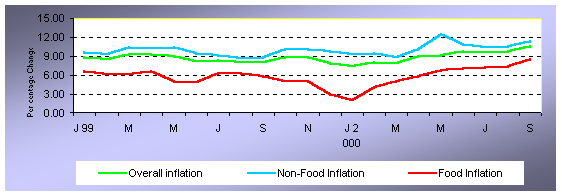 Chart 2 Price Trends (Annual Changes)
Chart 2 Price Trends (Annual Changes)
High imported inflation was partly attributable to the depreciation of the Rand to which Namibia currency is pegged. Accordingly, imported inflation recorded a noticeable increase of 11.8 per cent during the period under review as compared with 10.1 per cent during the corresponding period of the preceding year. However, domestic inflation by and large remained stable at around 7.3 to 7.4 per cent during the current and preceding years. This suggests that the source of inflationary pressure stemmed mainly from imported goods.
In line with the persistent increase in fuel prices and the depreciation of the Rand, producer price inflation for imported commodities (in South Africa) showed an increase of 14.4 per cent during the period January to October. The corresponding rate stood at 7.6 per cent during the same period of last year. The producer price inflation for locally produced commodities showed an increase of 7.1 per cent during the period January to October as compared with an increase of 5.1 per cent recorded during the same period of last year.
The instability of the domestic currency and the high fuel prices are mainly an outcome of the external factors. As such caution need to be exercised in estimating the impact of these external shocks on the domestic economy. Since the macro-economic fundamentals in Namibia continue to be strong, the adverse impact of such shocks has been contained so far. However, if this situation persists, policy intervention could become inevitable in order to curb inflation and ensure macro-economic stability. Moreover, the adoption of the value-added tax could also cause a once and for all change in the levels of the affected products during the fourth quarter of 2000 and probably extending up to the first quarter of 2001.
Monetary and Finacial Developments
Despite the sharp depreciation of the South African Rand in 2000 and the mounting of inflationary pressure in the wake of high international oil prices, the stance of monetary policy (by the monetary authorities of the CMA) remained the same as in the first half of the year. This stance was followed so as to ensure that growth is not unduly affected in the member countries. As a result, the Bank Rate (Bank of Namibia’s main operational instrument of monetary policy management) remained unchanged at 11.25 per cent for most of the year though there has been an upward revision in the Repo Rate by the South African Reserve Bank by 25 basis points to 11.50 per cent. It may, however, be noted that on account of higher inflation, the real Bank Rate steadily declined throughout the year. For example, whereas the real Bank Rate stood at 3.8 per cent in January 2000, it fell steeply to 0.6 per cent as at the end of September 2000.
It is to be noted that most money market rates in Namibia remained either unchanged or moved slightly downwards during the year under review. The average prime lending rate and the average mortgage rate of commercial banks remained unchanged at 15.9 and 15.7 per cent, respectively. However, in the wake of higher inflation their respective real rates declined throughout the year. Whereas the average real prime rate of commercial banks remained at 7.5 per cent as at the end of March, 2000 it declined to 4.7 per cent by the end of September. Similarly, the average real mortgage rate of commercial banks moved down from 6.4 per cent in June to 5.1 per cent as at the end of September 2000.
Responding closely to the above developments, the average nominal deposit rate of commercial banks also declined from 8.35 per cent in January to 7.07 per cent and to 6.96 per cent in June and September, respectively. In real terms, the average deposit rate, which stood at –2.3 per cent as at the end of June fell to –3.7 per cent at the end of September 2000. Although the phenomenon of low real interest rates augurs well for potential investors, it acts as a major deterrent for individuals and businesses in holding their deposits in the wake of a low or negative rates of return. It may also render the deposit mobilisation process rather tough for the banks as such a development might entice depositors to keep more of their money in the form of cash balances rather than in deposits. In this respect, it may be more prudent to reduce the spread rather than forcing the deposit rate downwards. It is also important to note that the real low rates did not translate into substantially more credit being taken up for investment purposes with the exception of mortgage loans.
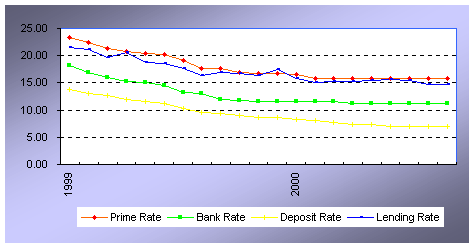 Chart 3. Selected Interest Rates
Chart 3. Selected Interest Rates
Activities on the capital market front have rather been subdued throughout 2000 as reflected in the passive trends witnessed on the Namibia Stock Exchange (NSX). The locally listed companies in particular have suffered a set back. The NSX witnessed a decline in turn over as well as in share prices during the year 2000 as compared with the preceding year viz., 1999. As a result, the market capitalisation of the NSX has been declining throughout the year. During 2000, the overall market capitalisation of the NSX declined from N$333.1 billion as at the end of December 1999 to N$301.1 billion as at the end of March 2000. The decline in market capitalisation continued in the second quarter of 2000 when it reached a low of N$291.3 billion. During the third quarter, however, it recovered marginally to N$322.8 billion. The decline in the overall market capitalisation was mainly a result of a drop in the share prices. The overall price index decline moved from 292 as at the end of 1999 to 263 as at the end of March 2000. It declined further to 254 as at the end of June 2000 before recovering to a level of 283 as at the end of September 2000.
On the local front, the scenario has been somewhat depressing in the sense that throughout the year activities remained subdued. Both the local market capitalisation and the price index moved downward from quarter to quarter in line with the overall market developments. Local market capitalisation declined from N$4.3 billion as at the end of December 1999 to N$4.0 billion as at the end of March 2000. It further declined to N$3.2 billion as at the end of June 2000. As at the end of September 2000, it stood at a low of N$2.7 billion, representing a decline of 37.2 per cent since the beginning of the year. Correspondingly, the local price index declined from 157 as at the end of December 1999 to 146 as at the end of March and to 123 and further down to 107 as at the end of June and September 2000, respectively.
There has been an acceleration in the average annual growth of broad money supply (M2) during the first half of 2000 as compared with the corresponding period of the preceding year. However, the situation got reversed during the third quarter of 2000 when the average annual growth rate of money supply decelerated to 8.7 per cent as compared with a growth of 14.4 per cent in the corresponding quarter of 1999. The annual rate of increase in broad money supply for the year ending September 2000 was 5.7 per cent, significantly lower than the 18.6 per cent level recorded for the year ending September 1999. The slow down in the growth in money supply as at end September 2000 is mainly attributable to the decline in the net foreign assets of the banking system. The main factors responsible for the increase in money supply during the year was private sector credit, which increased by 13.1 per cent as at end September 2000. This sharp increase in private sector credit occurred in the wake of relatively low interest rates since the later part of 1999.
Chart 4 Monetary Aggregates (Annual Percentage Changes)
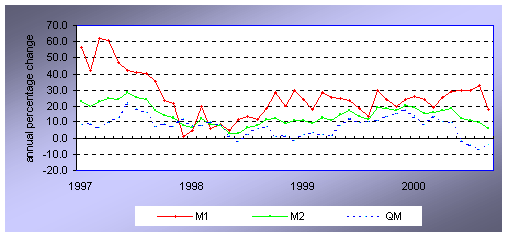
It is noteworthy that the annual growth rate of private sector credit accelerated gradually throughout the year. For the first half of the year, the average annual growth rate of private sector credit stood at 8.3 per cent, but during the second half of the year it moved up to 11.9 per cent.
The private sector credit, however, was characterised, as indicated by the chart below by a strong growth in credit to individuals. The annual growth rate of credit to individuals remained above 10 per cent throughout the year and as at the end of September, it reached a peak of 18.2 per cent. It is encouraging to note that there has been a turn around in the annual growth rate of credit to the business sector apparently responding to lower interest rates during 2000. The growth rate, which was still negative as at the beginning of the year turned positive towards the end of the first quarter (3.2 per cent in March). It started rising steadily thereafter to reach a peak of 11.8 per cent as at the end of June 2000.
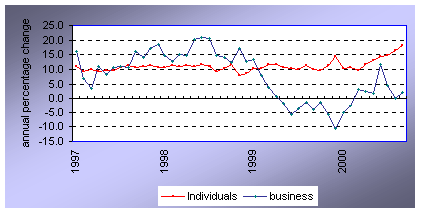
Preliminary estimates indicate a comparatively better fiscal scenario this year as compared with the preceding year. The budget deficit for the first six months of the fiscal year 2000-01 may be placed at N$525 million as compared with N$547 million during the corresponding period of the preceding year. This represents a decline of 4 per cent in the budget deficit.
About 60per cent of the budget deficit of the first six months of the current fiscal year was financed by the withdrawal of cash balances at the Bank of Namibia, whereas the remaining share came from the net issue of TB’s and Bonds. An aggregated amount of N$3 879.3 million in treasury bills and bonds was issued during the first half of fiscal year 2000-01. During the same period, an amount aggregating to N$3 673.5 million government securities was redeemed. This resulted in a net issue of government securities amounting to N$229.7 million.
Balance of Payments and Exchange Rate Developments
The balance of payments struck a favorable note during the first nine months of 2000, similar to the developments witnessed during the same period in 1999. It increased by N$ 553.1 million to reach a level of N$ 2 012.0 million by September 2000. The favourable situation was an outcome of high SACU transfers coupled with a substantial improvement in net services(chart 7) which offset the effects of the worsening trade balance.
Chart 6 Current Account Aggregates of Balance of Payments, 1999 Q1-2000 Q3
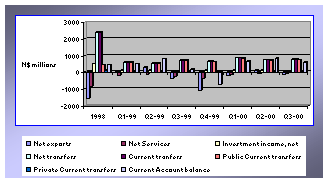
During the first nine months of 2000, the deficit in net exports stood at N$ 214.7 million while it stood at N$ 104.0 million during the corresponding period of 1999. This shows that during 2000, the deficit in net export worsened by N$ 110.7 million over that recorded in 1999. Though exports displayed a strong growth of 9.8 per cent over this period, imports have witnessed a still higher rate of growth of 11.5 per cent.
The rise in the value of exports receipts during the first nine months of 2000 was driven mainly by diamond exports that rose by 14.7 per cent. This rise in receipts was mainly an outcome of favourable international selling price for diamonds though the volume of diamonds that was exported in the same period declined by 4.0 per cent. The values of other export items have also recorded moderate growths during this period, other mineral products, food and live animals and manufactured products recorded growth rates of 12.8 per cent, 8.1 per cent and 3.7 per cent, respectively.
The stability in the external value of the Namibia dollar against major currencies, which featured prominently during 1999, was however disturbed in the first half of 2000 (chart 8). After trading at a twelve months average of N$6.1096 and a nine months average of N$ 6.1087 per US dollar for 1999, the external value of the Namibia dollar declined to an average of N$ 6.6037 per US dollar in the first nine months of 2000. When compared with the same period of 1999, the average for nine months in 2000 represents a depreciation of 7.5 per cent.
Chart 7 Foreign currency per Namibia dollar, 1996 to 2000
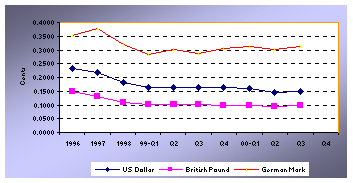
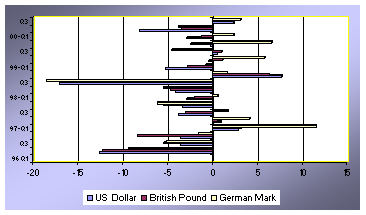 Chart 8 (-) Depreciation (+) Appreciation in NAD since Q1-96 to Q3
Chart 8 (-) Depreciation (+) Appreciation in NAD since Q1-96 to Q3
The depreciation was mainly caused by the appreciation in the external value of the US dollar that gained momentum against other major currencies in the international currency market and the investment concerns in the global financial markets about Sub-Saharan Africa following the land crisis in Zimbabwe. However, this downward pressure on the Namibia dollar suffered against major currencies in the first half of 2000 did not continue in the third quarter. A recovery in the external value of the currency came about mainly because of the return of business confidence in sub-Sahara and the weakening in the value of the US dollar against other major international currencies. However, this recovery in the third quarter did not last long as the external value of the Rand and therefore the Namibia dollar has depreciated against the U$ dollar in the first two months of the fourth quarter of 2000.
Expectation toward the end of 1999 was that of a remarkable upward shift in economic growth in the year 2000 and beyond. Although this is likely to be true in the ensuing year and the medium term, the near-term prospects however, are not that bright. The upswing is expected to be more remarkable next year, i.e. in the year 2001, as overall GDP is forecast to rise by about 5 per cent. Mining is expected to spur the process growth during 2001. Both non-diamond and diamond mining are expected to register strong growth rates given the resumption of the TCL mines and the continued strong foreign demand for minerals. Overall, mining could reach a growth rate of about 6 per cent next year. Agriculture and fishing are also expected to recover and as a result the whole primary sector would record a higher growth rate than that witnessed during 1999. The construction of the two new mines and that of other envisaged projects will strongly boost the value added of the construction sector which remained subdued during the current year, despite the low interest rates. The apparent interest-sensitive service sector is also expected to grow by about 4 per cent.
Inflation has been on a rising trend during the current year, mainly due to acceleration of imported inflation resulting from higher food prices (partly flood related), the weak Rand and the hikes in oil prices. There is however some optimism that pressure from these external shocks could be temporary and the medium term inflation outlook could be favourable. The key reasons for this optimism is the prevalence of disinflationary forces at work. The ongoing trend in wage moderation, and the still very competitive environment in the South African economy will slowdown imported inflation in Namibia and as a result the overall inflation rate is expected to come down in the medium term.
It is expected that the present stance of monetary policy in South Africa is likely to continue and interest rates in Namibia would therefore remain broadly in line with the rates in South Africa.
The Namibian economy has been able to steer clear of external shocks without much of an adverse impact. Whereas many economies across the globe suffered high levels of inflation and weaknesses in their economies, Namibia though suffered to some extent on the exchange rate and price fronts, continued to display resilience and potential for growth. The prudent management of policy issues on the monetary side which ensured a low interest rate regime, particularly during the current year, has been the major factor behind this achievement. However, there is no room for complacency. The economy needs to be further strengthened in terms of achieving fiscal sustainability and in working towards a sound banking and financial structure backed by an effective and efficient Payment and Settlement System. In order to restore the growth momentum which suffered a set back during the current year, it is imperative to ensure that the genuine requirements of trade and industry are adequately met by the banking and the financial system and there is a compositional shift in the allocation of credit (towards ‘business’ rather than to ‘individuals’) in this direction.